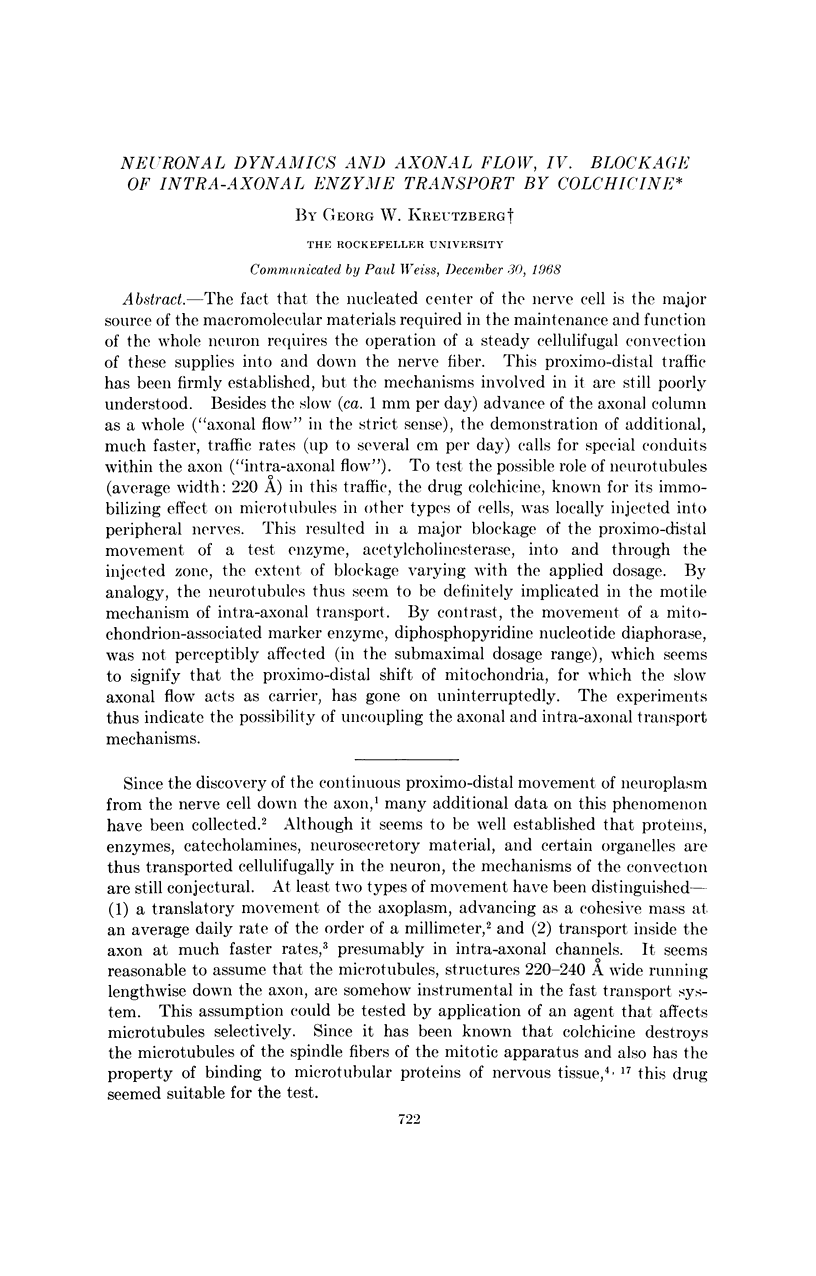NEURONAL DYNAMICS AND AXONAL FLOW, IV. BLOCKAGE OF INTRA-AXONAL ENZYME TRANSPORT BY COLCHICINE (original) (raw)
Abstract
The fact that the nucleated center of the nerve cell is the major source of the macromolecular materials required in the maintenance and function of the whole neuron requires the operation of a steady cellulifugal convection of these supplies into and down the nerve fiber. This proximo-distal traffic has been firmly established, but the mechanisms involved in it are still poorly understood. Besides the slow (ca. 1 mm per day) advance of the axonal column as a whole (“axonal flow” in the strict sense), the demonstration of additional, much faster, traffic rates (up to several cm per day) calls for special conduits within the axon (“intra-axonal flow”). To test the possible role of neurotubules (average width:220 Å) in this traffic, the drug colchicine, known for its immobilizing effect on microtubules in other types of cells, was locally injected into peripheral nerves. This resulted in a major blockage of the proximo-distal movement of a test enzyme, acetylcholinesterase, into and through the injected zone, the extent of blockage varying with the applied dosage. By analogy, the neurotubules thus seem to be definitely implicated in the motile mechanism of intra-axonal transport. By contrast, the movement of a mitochondrion-associated marker enzyme, diphosphopyridine nucleotide diaphorase, was not perceptibly affected (in the submaximal dosage range), which seems to signify that the proximo-distal shift of mitochondria, for which the slow axonal flow acts as carrier, has gone on uninterruptedly. The experiments thus indicate the possibility of uncoupling the axonal and intra-axonal transport mechanisms.

Images in this article
Selected References
These references are in PubMed. This may not be the complete list of references from this article.
- ANGEVINE J. B., Jr Nerve destruction by colchicine in mice and golden hamsters. J Exp Zool. 1957 Nov;136(2):363–391. doi: 10.1002/jez.1401360209. [DOI] [PubMed] [Google Scholar]
- Borisy G. G., Taylor E. W. The mechanism of action of colchicine. Colchicine binding to sea urchin eggs and the mitotic apparatus. J Cell Biol. 1967 Aug;34(2):535–548. doi: 10.1083/jcb.34.2.535. [DOI] [PMC free article] [PubMed] [Google Scholar]
- Dahlström A. Effect of colchicine on transport of amine storage granules in sympathetic nerves of rat. Eur J Pharmacol. 1968 Dec;5(1):111–113. doi: 10.1016/0014-2999(68)90165-9. [DOI] [PubMed] [Google Scholar]
- FRIEDE R. L. Transport of oxidative enzymes in nerve fibers: a histochemical investigation of the regenerative cycle in neurons. Exp Neurol. 1959 Nov;1:441–466. doi: 10.1016/0014-4886(59)90043-3. [DOI] [PubMed] [Google Scholar]
- HOFFMAN H. Acceleration and retardation of the process of axon-sprouting in partially devervated muscles. Aust J Exp Biol Med Sci. 1952 Dec;30(6):541–566. doi: 10.1038/icb.1952.52. [DOI] [PubMed] [Google Scholar]
- KREUTZBERG G., WECHSLER W. HISTOCHEMISCHE UNTERSUCHUNGEN OXYDATIVER ENZYME AM REGENERIERENDEN NERVUS ISCHIADICUS DER RATTE. Acta Neuropathol. 1963 Apr 2;3:349–361. doi: 10.1007/BF00685992. [DOI] [PubMed] [Google Scholar]
- Kasa P. Acetylcholinesterase transport in the central and peripheral nervous tissue: the role of tubules in the enzyme transport. Nature. 1968 Jun 29;218(5148):1265–1267. doi: 10.1038/2181265a0. [DOI] [PubMed] [Google Scholar]
- NACHLAS M. M., WALKER D. G., SELIGMAN A. M. A histochemical method for the demonstration of diphosphopyridine nucleotide diaphorase. J Biophys Biochem Cytol. 1958 Jan 25;4(1):29–38. doi: 10.1083/jcb.4.1.29. [DOI] [PMC free article] [PubMed] [Google Scholar]
- Schlaepfer W. W., Torack R. M. The ultrastructural localization of cholinesterase activity in the sciatic nerve of the rat. J Histochem Cytochem. 1966 May;14(5):369–378. doi: 10.1177/14.5.369. [DOI] [PubMed] [Google Scholar]
- Weiss P., Pillai A. Convection and fate of mitochondria in nerve fibers: axonal flow as vehicle. Proc Natl Acad Sci U S A. 1965 Jul;54(1):48–56. doi: 10.1073/pnas.54.1.48. [DOI] [PMC free article] [PubMed] [Google Scholar]
- Wisniewski H., Shelanski M. L., Terry R. D. Effects of mitotic spindle inhibitors on neurotubules and neurofilaments in anterior horn cells. J Cell Biol. 1968 Jul;38(1):224–229. doi: 10.1083/jcb.38.1.224. [DOI] [PMC free article] [PubMed] [Google Scholar]
- Wiśniewski H., Terry R. D. Experimental colchicine encephalopathy. I. Induction of neurofibrillary degeneration. Lab Invest. 1967 Dec;17(6):577–587. [PubMed] [Google Scholar]